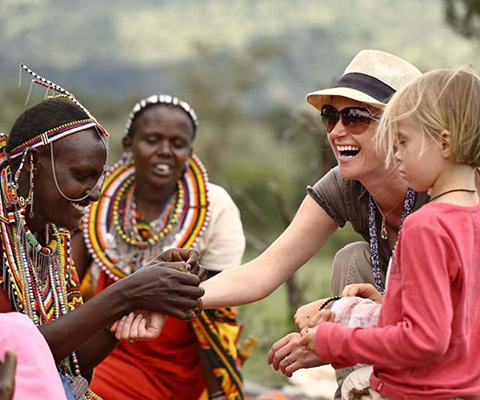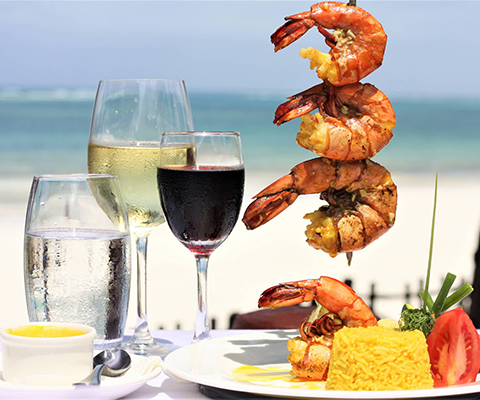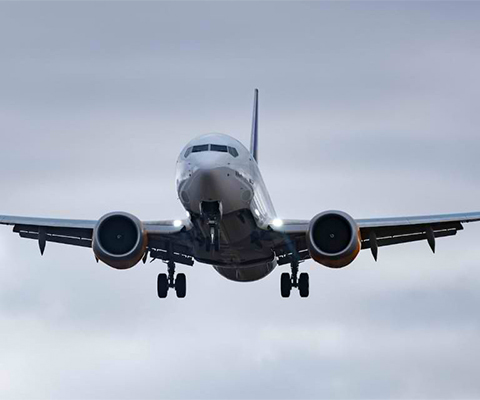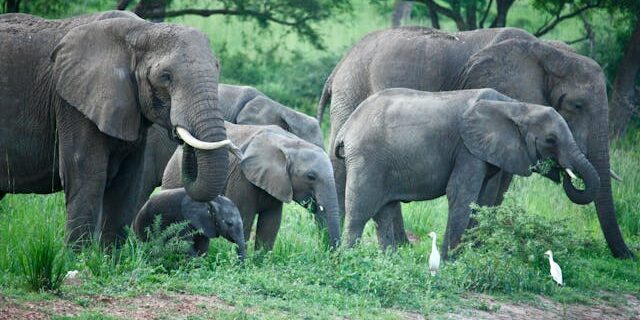By Caroline Kajuju
Within Kenya’s borders lie eight UNESCO World Heritage sites, each offering a distinct narrative. You get to see the fossil-rich terrains of Lake Turkana, which reshaped our understanding of human evolution, and the ancient Swahili settlements along the coast that whisper stories of global trade and cultural fusion. These sites are not merely tourist attractions; they are chapters in a much larger story about our country and its people. To explore Kenya’s World Heritage is to journey through the origins of life, the resilience of nature, and the enduring spirit of human creativity.
Fort Jesus
It was built between 1593 and 1596 by the Portuguese. Fort Jesus is located in Mombasa. It is the ideal starting point for understanding how cultures clashed and blended on the shores of Eastern Africa. Its massive coral stone walls have withstood the centuries of war.
Fort Jesus was added to the UNESCO World Heritage List in 2011. Below are places within Fort Jesus walls that make a visit worthwhile.
The Museum
Located at the heart of the fort is the Fort Jesus Museum, a repository of maritime heritage. Here, visitors can view impressive displays, including pieces from 42 Portuguese warships that were scuttled during the Omani siege of 1696. Among the items that a visitor is privileged to tour are pottery, weapons, and ancient navigation devices.
Mazrui Hall
This museum showcases Fort Jesus’ rich heritage through a diverse collection of artifacts and inscriptions. You will view graffiti and drawings left behind by Portuguese marines, drawings of Arab dhows, and depictions of the mtepe, the traditionally sewn-plank sailing boat of the Swahili.
The Oman House
This late-18th-century structure, previously the residence of the Omani Sultan, has been transformed into a museum showcasing Oman’s rich culture.
Swahili Cultural Centre
The Swahili Cultural Centre was formed in 1993. It helps to conserve Swahili culture and enhance community livelihood. The centre equips the youth with craft-making skills, such as woodcarving, embroidery, and basketry, as well as business skills.
Conservation of Fort Jesus includes the museum, research projects, a Conservation Lab, and an Education Department.
Sacred Mijikenda Kaya Forest
The Sacred Mijikenda Kaya Forest consists of 10 forested sites. They were once fortified settlements and remain sacred sites of ritual, prayer, and counsel.
The Kaya forests were listed on the UNESCO World Heritage list in 2008. They serve as a window into the religious beliefs of Kenya’s indigenous peoples and a testament to how nature is preserved through community culture. Admission is by permit only, and respect is necessary.
Mount Kenya National Park/Natural Forest
Mount Kenya National Park has been designated a UNESCO World Heritage Site since 1997 and again in 2013. The park is home to glaciers, alpine grasslands, and a variety of animals, including the Mount Kenya hyrax. Climbers have access to Mount Kenya’s summit, while nature enthusiasts enjoy summit walks within the moorlands and bamboo forests.
Mount Kenya National Park offers a range of attractions which include;
Mount Kenya Peaks: Batian, Nelion, and Point Lenana
The core of the park is Mount Kenya, Africa’s second-highest peak at 5,199 meters. It has three prominent peaks: Batian, Nelion, and Point Lenana, with the latter being accessible to climbers. Below are the routes used to climb Mount Kenya’s Point Lenana, which vary in difficulty.
Chogoria Route
The Chogoria Route is scenic, leading climbers through forests that pass beside Lake Michaelson. This glacial lake is situated at the foot of great cliff walls and features serene areas perfect for relaxation and photography.
Sirimon Route
The Sirimon Route is a relatively easy trek to Mount Kenya that goes to Shipton’s Camp. Shipton’s Camp is a popular stopping point for mountain climbers, offering a beautiful view of the surrounding peaks. It is suitable for intermediate to experienced climbers.
Naro Moru Route
The Naro Moru Route is a favourite with its direct route to Point Lenana. It has unique scenery, such as the Vertical Bog, and its end is at Mackinder’s Camp. It is an excellent option for those who prefer a challenging yet rewarding trek and is best suited for experienced hikers.
Mau Mau Cave
Camouflaged within the park’s forests is the Mau Mau Cave. It served as a hideout for African freedom fighters who struggled against the British colonial government during the Mau Mau Uprising. It lasted from 1952 to 1960. This historical monument serves as a valuable lesson on the nation’s struggle for independence and is also a poignant point of historical significance among historians.
Lower Slopes and Forests
The park’s lower slopes are covered with rainforest and high concentrations of bamboo, as well as a range of animals, including elephants, bushbucks, and over 130 bird species. Nature walks within these areas provide opportunities for bird and wildlife viewing.
Lakes and Rivers
There are crystal lakes and rivers all within Mount Kenya National Park. These include Lake Alice, Lake Rutundu, to Lake Ellis. These are the foundation of the aquatic ecosystem within the park.
Ngare Ndare Forest
Adjacent to Mount Kenya National Park is the Ngare Ndare Forest, a forest with a natural canopy walk, Azure pools, and six natural falls. It is a haven for wildlife, offering guests a firsthand view of nature’s majesty.
Lake Turkana National Park
Lake Turkana National Park, listed as a UNESCO World Heritage site since 1997 and 2001, is the world’s largest desert-centred perennial lake and a “Cradle of Mankind.” It’s composed of three parks;
Sibiloi National Park
Located on the northeastern shores of Lake Turkana, Sibiloi is renowned for its rich fossil record. In Koobi Fora, hominid fossils have been found. Visitors also see the Petrified Forest and the Jarigole Pillars.
Central Island National Park
A volcanic island with three crater lakes, Crocodile Lake, Flamingo Lake, and Tilapia Lake. It’s an important breeding site for Nile crocodiles.
South Island National Park
This volcanic island is also a breeding site for Nile crocodiles and home to venomous snakes such as the carpet viper.
Kenya Lake System in the Great Rift Valley
The Lake System in the Great Rift Valley was inscribed on the UNESCO World Heritage List in 2011. It encompasses three remarkable alkaline lakes: Lake Bogoria, Lake Nakuru, and Lake Elementaita. Each of the lakes is distinct, with its unique natural attributes, and is renowned for its high biodiversity, including a diverse array of bird life.
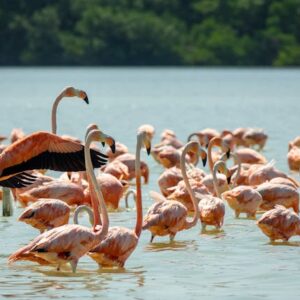
Graceful flamingos wading through the waters of Lake Nakuru
Lake Bogoria
It is renowned for its geothermal activity, featuring numerous geysers and hot springs along its lakeshores. Thousands of lesser flamingos assemble at the lake’s alkaline waters to form a beautiful pink spectacle against the backdrop of the Rift Valley escarpment. Lake Bogoria National Reserve, which surrounds the lagoon, is home to a diverse range of animals, including zebras, gazelles, and baboons.
Lake Nakuru
Lake Nakuru is situated within Lake Nakuru National Park. It is a paradise to a diverse range of birdlife and wildlife. It’s globally renowned for its enormous flamingo concentrations and is home to over 450 bird species. The national park also hosts several endangered mammals, including black and white rhinos, Rothschild’s giraffe, and lions.
Lake Elementaita
Between Lake Naivasha and Lake Nakuru lies Lake Elementaita, a serene soda lake renowned for its ecological significance. It is also a very important breeding area for great white pelicans and home to a diverse range of birdlife. Surrounding the area are the Kekopey hot springs, which provide habitats for a variety of flora and fauna.
Lamu Old Town
Lamu is the oldest inhabited town in Kenya. It was founded in the 14th century and showcases Swahili architecture at its best. Narrow streets, coral limestone structures, and elaborately carved wooden doors evoke a sense of times gone by. Lamu Old Town was declared a UNESCO World Heritage Site in 2001.
Some of the most popular tourist attractions include:
Lamu Museum
Occupying a historic structure established in the early 20th century, the Lamu Museum boasts an extensive collection of Swahili ethnographic items. Exhibited are the region’s historical attire, jewelry, manuscripts, and sea gear that articulate the diverse cultural heritage. Exhibited within the museum are works written by the renowned Swahili poet and carver, Mohammed Kijumwa.
Lamu Fort
Lamu Fort was built with the Omani assistance between 1813 and 1821. It was initially a defense area, which later turned into a British colonial prison. Today, Lamu Fort is home to a museum on environmental matters and a public library.
German Post Office Museum
This museum is a replica of the post office established by the Germans on the Eastern African coast in 1888. It provides insight into the town’s world of communication and trade during that time.
Swahili House Museum
It offers a first-hand experience of the typical Swahili home life. Visitors gain a glimpse of the architectural styles and interior decor typical of Swahili homes, thereby gaining a deeper understanding of the region’s culture and society.
Takwa Ruins
It is located on Manda Island. The Takwa Ruins are all that remain of a Swahili settlement dating back to the 16th century. A preserved mosque and a pillar tomb are located on the site, providing a glimpse into the rich religious and architectural diversity of the Swahili culture.
Thimlich Ohinga Archaeological Site
Thimlich Ohinga is a dry-stone field enclosure that was built over 500 years ago. It was a protective communal enclosure for those who were within. It has been a UNESCO World Heritage Site since the year 2018. The walls stand with no mortar. They are a testament to engineering and social administration. Thimlich Ohinga is not a popular tourist destination, but it reveals old settlement patterns in western Kenya. Thimlich Ohinga is situated near several notable attractions.
- Gogo falls.
- Lake Victoria.
- Rusinga Island.
- Ruma National.
- Park Macalder gold mines.
Conservation work on the Thimlich Ohinga archaeological site focuses on ensuring the walls’ integrity and promoting the historical value of the site
Historic Town and Archaeological Site of Gedi
It is situated within the Arabuko-Sokoke Forest in Watamu, Kilifi County. The site serves as a beautiful testament to ancient Swahili culture in Kenya. It was inscribed as a UNESCO World Heritage Site in July 2024. The site comprises a walled town featuring stone-built structures, including mosques, a palace, residences, and traditional pillar tombs. Artifacts found here, including imported ceramics and coins, indicate the significance of Gedi within the Indian Ocean’s trade networks.
Among its conservation efforts is the protection of ruins and public education about its historical significance.
Places to Visit near Gedi.
There are places near Gedi that make the visit worthwhile. A few of these include:
Watamu Marine National Park
Right next to Gedi is Watamu Marine National Park. This park, with its white-sand beaches and coral reefs, is an ideal place for those with a flair for snorkelling and diving. It is home to many varieties of fish, dudongs, turtles, and bird life.
Arabuko-Sokoke Forest
Arabuko Sokoke Forest encompasses the Gedi ruins. It is home to rare bird species, including the Sokoke Scops Owl.
Mnarani Ruins
Located in Kilifi, these 15th-century ruins feature ancient mosques and tombs perched on a bluff overlooking Kilifi Creek, offering insights into early Swahili settlements.
Travel Tips
- Travel responsibly and use local guides.
- Don’t litter or harm natural formations.
- Respect cultural traditions, especially those of a religious nature.
UNESCO status is a privilege and a responsibility. These sites must be protected against overdevelopment, climate change, and neglect. They boost the local economy and cultural pride. Add one of these sites to your itinerary. If you’re not sure where to start, please don’t hesitate to reach out. You’ll leave with a deeper understanding and a sense of connection.


